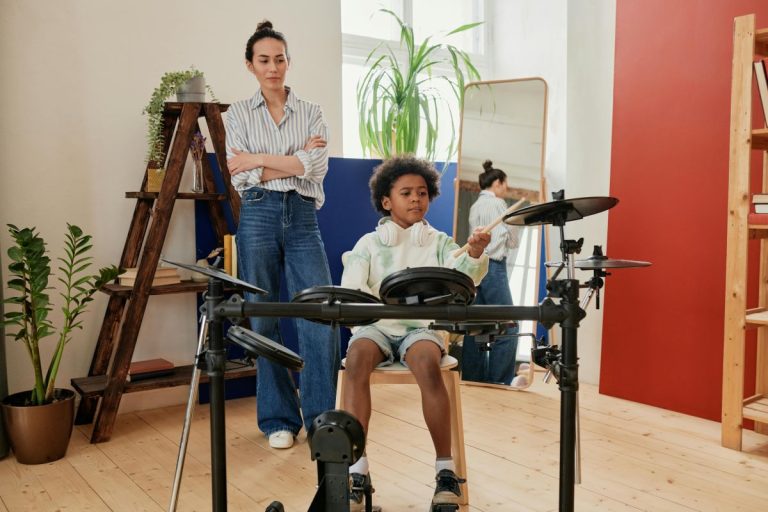Drumming is more than just hitting things with sticks—it’s the heartbeat of any band. For beginners, the world of percussion can seem overwhelming at first, but with the right foundation, you’ll find yourself grooving along in no time. Whether you dream of playing in a band, backing up your favourite tracks, or simply learning a new skill, this guide will walk you through the essential steps of how to play drums for beginners.
At Studio 72, we help aspiring drummers gain confidence behind the kit with structured, enjoyable lessons tailored to individual needs.
What is a Drum Kit?

A standard drum kit consists of various percussion instruments arranged in a convenient layout for the drummer. The most common components include:
- Snare Drum
- Bass Drum (with foot pedal)
- Hi-Hats
- Toms (High, Mid, Floor)
- Crash and Ride Cymbals
Some kits may also include extra percussion like cowbells, splash cymbals or electronic pads.
Step 1: Get Familiar with Drum Kit Components
Before you play, know your instrument. Sit behind the drum kit and observe how each component functions. Familiarise yourself with how each piece sounds and where it sits within the layout.
Acoustic vs. Electronic Drums
- Acoustic Drums: Traditional, louder, better dynamics
- Electronic Drums: Quieter, great for practising at home, come with headphone support
If you’re starting at home, electronic kits are often more practical. But both are great tools, depending on your goals.
Naming and Placement of Drums
Set up your kit to fit your body ergonomically. Here’s a basic placement:
Drum Component | Standard Position |
Snare Drum | Centre, between your knees |
Bass Drum | Front, played with the right foot |
Hi-Hat | Left side, foot-operated |
Tom-Toms | Above the bass, right side |
Floor Tom | Right-hand side |
Crash Cymbal | Left or right, above toms |
Ride Cymbal | Far right |
Step 2: Learn How to Hold Drumsticks Properly
Your grip influences your control, speed, and comfort. There are two common types:
Matched Grip vs Traditional Grip
- Matched Grip: Both hands hold sticks the same way (standard for beginners)
- Traditional Grip: Used in jazz and marching bands (left-hand underhand)
Always keep your grip relaxed. Tension leads to fatigue and injury.
Step 3: Develop Basic Hand Techniques
Every great drummer started with a single stroke. Techniques you’ll build now will last your entire musical journey.
Single Stroke and Double Stroke Rolls
- Single Stroke Roll: RLRLRLRL
- Double Stroke Roll: RRLLRRLL
Start slowly, using a metronome, and build speed over time.
Importance of Stick Control and Rebound
Let the stick bounce naturally after hitting the drum. This rebound makes playing smoother and more energy-efficient.
Step 4: Master Your First Drum Beat
One of the first grooves beginners learn is the basic rock beat—a foundation for countless songs.
Basic Rock Beat for Beginners
- Hi-hat plays 8th notes
- Snare on beats 2 and 4
- Bass drum on beats 1 and 3
This simple rhythm helps develop timing and coordination.
Playing Along with a Metronome
Practising with a metronome builds internal timing and consistency. Start slow—around 60–70 BPM—and increase gradually.
Step 5: Learn Simple Drum Fills
Drum fills connect sections of music and add excitement. Begin with easy fills like hitting each drum in a sequence (e.g. Snare, High Tom, Mid Tom, Floor Tom).
Try this pattern:
- 1 e & a 2 e & a 3 e & a 4 e & a
- R L R L R L R L (around the kit)
Step 6: Practise with Songs You Love
Applying what you’ve learned to real music boosts motivation and enjoyment.
Recommended Beginner Tracks
- “Seven Nation Army” – The White Stripes
- “We Will Rock You” – Queen
- “Smoke on the Water” – Deep Purple
These tracks have simple rhythms that are ideal for newcomers.
Building Confidence Through Repetition
Don’t be afraid to repeat the same groove until it feels natural. Muscle memory is built through steady practice.
Step 7: Join a Drum Lesson or Practice Group

While self-learning has its place, guided lessons can fast-track your progress.
Benefits of Professional Drum Lessons
- Correct bad habits early
- Structured learning path
- Personalised feedback
How Studio 72 Supports Beginner Drummers
At Studio 72, we go beyond technique—we foster creativity, discipline, and joy in music.
Expert Coaches & Community-Based Learning
Our instructors offer years of performance and teaching experience. You’ll also join a friendly community of fellow learners.
Learn in a Fun, Creative Space in Singapore
From the moment you step into Studio 72, you’ll be welcomed into a vibrant, supportive environment designed to inspire musical discovery. Our studio isn’t just a place to practise—it’s a creative hub where students of all levels feel encouraged to explore, express, and grow.
Whether you’re a complete beginner or looking to refine your skills, our drum classes offer a structured yet fun way to learn. With top-notch facilities, experienced instructors, and a community that thrives on passion for music, you’ll find everything you need to start your drumming journey with confidence.
Conclusion
Drumming is an exhilarating journey that begins with one simple beat. With patience, consistency, and the right guidance, anyone can learn how to play drums. At Studio 72, we’re here to help beginners unlock their musical potential in a supportive and fun environment.
Whether you’re a complete novice or someone picking up the sticks again, there’s never been a better time to start. Book your first lesson today and feel the rhythm take over.
FAQs
How do I start learning drums as a complete beginner?
Begin by familiarising yourself with the basic components of a drum kit and understanding fundamental rhythms. Practising simple beats and rudiments can build a strong foundation. For structured guidance, consider enrolling in beginner-friendly drum lessons, such as those offered at Studio 72, where experienced instructors tailor sessions to your skill level.
Can I learn to play drums without owning a drum set?
Absolutely. Many beginners start with practice pads or even household items to develop timing and coordination. Studio 72 provides access to well-equipped drum kits during lessons, allowing you to practise without the immediate need to invest in your own set.
How long does it typically take to learn basic drum skills?
The timeline varies per individual, but with consistent practice, many beginners can play simple beats within a few weeks. Regular lessons, like those at Studio 72, can accelerate your progress by providing structured learning and feedback.
What equipment do I need to start drumming?
Initially, a pair of drumsticks and a practice pad suffice. As you advance, you might consider investing in a drum kit. We offer guidance on selecting suitable equipment and provide all necessary gear during lessons, ensuring you have the right tools from the outset.
Is it necessary to read music to play drums?
While reading music can enhance your drumming skills, it’s not mandatory for beginners. Many drummers learn by ear and through patterns. At Studio 72, instructors can introduce you to basic drum notation as you progress, enriching your musical understanding.
Are there drum lessons available for adults?
Yes, drumming is suitable for all ages. We offer adult drum lessons tailored to individual goals, whether you’re starting anew or revisiting a past passion. The supportive environment ensures that adult learners feel comfortable and motivated.






